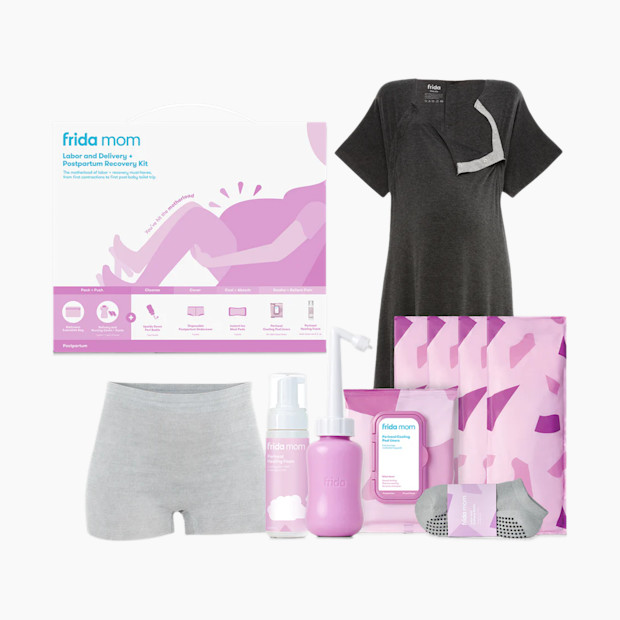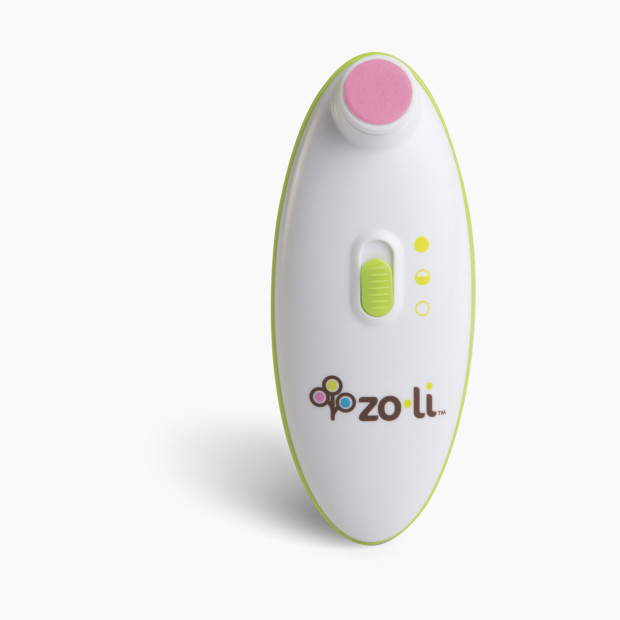
41 Weeks Pregnant
At 41 weeks, your baby's nails are still growing, and overall, they’re about the size of a Mac iBook.

By Babylist Staff
At 41 weeks gestation, your baby is considered “late term” since they’ve now gone a full seven days past their due date, but they’re still growing in there—in fact, they’re now about the size of a Mac iBook. You may be feeling some very early signs of labor, or you may be feeling zero difference from the previous few weeks. But neither the presence of labor symptoms nor the lack of symptoms indicate exactly when baby will show up.
According to Dr. Harvey Karp, pediatrician and founder of Happiest Baby, “since some of the early labor signs, like back pain, are indistinguishable from the other weird sensations of pregnancy, it’s possible your body will start labor without you knowing it.” So at this stage it’s best to stay prepared for going into labor no matter what you’re feeling. Read on to learn what all to expect at 41 weeks pregnant.
What To Expect at 41 Weeks Pregnant
How Many Months Is 41 Weeks Pregnant?
41 weeks pregnant in months is nine and a quarter months pregnant, which is part of the third trimester of pregnancy.
You’ve just peeked over the edge of the stereotypical “nine months” of pregnancy, but the truth is that full-term pregnancies can last anywhere from eight and a quarter months to nine and a half months.
Your Baby at 41 Weeks
So baby decided to bake a little longer. You thought they’d be ready to come out by now, so what in the world are they up to in there? As far as fetal development goes, all the major parts are finished—but there are a few small parts that continue to develop until birth and beyond:
- Hair and nails. Your baby’s hair and those nails are still growing. Make sure you have a set of baby-safe nail clippers on hand so baby doesn’t scratch themselves (or you) in the few days after they’re born.
- Fat. Your baby is basically full grown at this point, but they’re continuing to put on a bit of fat while they await the big debut.
- Dry skin. The longer they go past their due date, the more baby will lose the vernix (that protective, cheesy coating) from their skin. So they may be born with pretty dry skin.
Babies are generally still fine to be in-utero at 41 weeks, though your doctor will want to keep an eye on things, especially if you get closer to 42 weeks pregnant (“postterm”) with no signs of labor. “While the risk of pregnancy complications does increase from full term to late term, the biggest increase is seen in the postterm period,” says Dr. Christine Sterling, founder of the Sterling Parents community. Babies at 41 weeks gestation are at a slightly higher risk of complications like high birth weight (which can lead to maternal and fetal birth injuries as well as vaginal birth assisted by a vacuum or forceps, or unplanned C-section birth), longer-than-average labor time and metabolism problems.
If you’re worried about your baby overstaying their welcome, you can always talk to your doctor about having an induction—though induction is more likely to happen once you pass 41 weeks.
Fun Fact
Boy babies are more likely to go past 41 weeks than girls are.
How Big Is a Baby at 41 Weeks?
A 41 week fetus is about 14.3 inches long from crown to rump (around the same as 40 weeks) and weighs around 7.9 pounds. That’s about the size of a Mac iBook.
Your Body at 41 Weeks of Pregnancy
Your body has been through a lot these past 41 weeks. While you might consider it a testament of your strength, you might also just be really tired of being pregnant. Your belly may be getting even larger as baby continues to grow (even though you thought you’d burst weeks ago), and the exhaustion is real.
41 Weeks Pregnant Symptoms
The majority of symptoms for this week of pregnancy likely feel the same as at 40 weeks, Sterling says. But you might also notice subtle changes in urinary and bowel movements, increased Braxton Hicks contractions and increased back and pelvic pain thanks to baby putting on even more weight.
(Even More) Frequent Urination
Your baby may have dropped down into the pelvis in preparation for birth, which may have you running to the bathroom even more often than before.
Diarrhea
Some moms report getting diarrhea right before they go into active labor. If you get the runs, it might soon be go-time.
Braxton Hicks Contractions
You’re probably still feeling intermittent tightening in your belly as your body preps for labor. Keep an eye on those contractions. Eventually, they should get more frequent and intense, and that’s your sign that they’ve transitioned to real labor contractions.
Pregnancy Symptoms Coming up in Week 42
If you reach week 42 of pregnancy, here’s what to expect:
- Increased Braxton Hicks contractions. They may be harder to distinguish from real labor contractions. The key difference: real contractions are about five minutes apart, lasting 60 seconds each with increasing intensity.
- Stress. Going two whole weeks past your due date could be difficult for you, both physically and emotionally. Try your best to relax.
- Fatigue. Baby is still packing on the pounds even into week 42, giving you more weight to carry around and more general discomfort at all hours of the day and night, leading to some very understandable exhaustion.
Commonly Asked Questions About 41 Week Pregnant
Do I really need to be induced?
Not necessarily. Many doctors will recommend induction—jump-starting labor with medication such as Pitocin—for a pregnancy that goes past 41 weeks, since going into post-term (42 weeks or later) does put a baby at higher risk for complications. But how you and baby are doing can certainly affect the decision; talk over any findings from the nonstress test and/or ultrasound. Plus, there’s always the chance your conception date (and thus, due date) was miscalculated.
After discussing induction with the doctor, take the course of action that’s in the best interest of your and your baby’s health and well being. You might set a date for induction and need to use it if you don’t go into labor naturally before then. Or you might choose to give it a go now.
In order to induce labor, your cervix must have started to ripen (that means soften, efface and/or dilate). If yours shows no signs of that, your doctor might need to use a medication such as Cervidil to start the ripening process and then use Pitocin to kick off contractions.
What is an APGAR score?
Once your baby arrives, they will get their first test, called the APGAR. “The APGAR score is a tool used to assess how baby is adjusting to life outside of the womb,” Sterling says. Your baby’s nurse or midwife will examine five conditions: baby’s color, heart rate, reflexes, muscle tone and breathing.
The baby gets a score of zero, one or two for each of these, for a total possible score of 10. It’s given at one minute old and again at five minutes old. It helps your medical team know that your baby is healthy in the immediate moments following birth so they can intervene early and quickly if necessary, but that’s about all it’s for. “[The APGAR score] is not predictive of long-term health outcomes,” Sterling says.
And if you’re hoping for a perfect 10, keep in mind that “risk of low APGAR is higher in the post-term period compared with full term,” Sterling says.
Signs of Labor at 41 Weeks
At 41 weeks, probably every twinge and tingle has you wondering if it’s finally time to head to the hospital or birthing center. Look out for these signs of labor:
- Frequent contractions. Feeling real contractions yet? Unlike Braxton Hicks contractions, active labor contractions increase in intensity and length and get closer together as they progress. A contraction timer app can help you monitor whether or not they are really getting more frequent and longer.
- Water breaking. Another sign of labor starting is having your water break. This is not usually a gush of fluid (though that can happen), but a slow trickling down your leg.
You also want to keep on the lookout for any concerning symptoms, like bleeding or abdominal pain, or if your baby’s movement slows, and call the doc if you experience them.
What Happens After Birth?
Things might be rough going for a while. Whether you’re scheduled for your induction or you’re waiting for baby to arrive on their own, take this time to learn more about adjusting to life after pregnancy.
Your Body
If you have a vaginal birth, your perineum will be sore and healing for days or weeks. Try a cold pack or sitz bath for pain relief. (Ask the hospital for extra cold packs on your way out the door.) You will also likely be bleeding heavily for the first few days and wearing those postpartum mesh undies. The bleeding is likely to continue for at least a couple weeks, but it’ll get lighter pretty quickly.
If you had a cesarean birthyou should be very gentle with yourself. Don’t lift anything heavier than the baby for a few weeks. Take your pain medication (and stool softeners) for as long as you need. Try to stay as active as you can, even if it means a one-block walk once a day. This can really help recovery. (If they don’t offer it, ask the hospital for a belly band to help your abdominal muscles recover easier.)
Regardless of how your baby met the world, your uterus will start contracting, and this can cause cramping. Breastfeeding releases oxytocin, which helps your uterus contract, but that does mean you might have really painful cramps while breastfeeding.
That’s just downstairs.
Your breasts and belly will be all sorts of who knows what for a bit (you may still look pregnant for a few days or even a few months after giving birth—it’s completely normal). Your body made a baby and now it’s different. If you’re feeling down about this, here’s a video from a musician on why she decided not to get plastic surgery after her twins were born.
Your Mind
Baby blues are real, and so are postpartum anxiety and depression. How real? After pregnancy, between up to 85 percent of women have mood swings, including crying for no apparent reason. Be kind to yourself and enjoy your baby.
If you are still feeling blue more than a few weeks after birth and can’t shake the negative thoughts, talk to your doctor about it to see if you need more support.
Your Life
In the face of a flood of visitors and well-wishers, you may not feel like being social at all. Don’t feel obligated to entertain guests, and certainly don’t feel bad about telling people to give you some space for the first few weeks. Your only focus should be on yourself and your baby for the next few months.
Top Tip for 41 Weeks Pregnant
The hospital will give you basic baby care items: nasal aspirator, thermometer, etc. Ask for mom care items, too, like perineum cold packs or a Velcro belly band for your abdominal muscles.
Recommended Products for Week 41 of Pregnancy
As you continue to prepare for labor, delivery and caring for a newborn, these products can help with everything from postpartum recovery to moisturizing dry baby skin to keeping those sharp baby nails neat and trimmed.

Frida Mom
Labor and Delivery + Postpartum Recovery Kit

Lansinoh
Sitz Bath Salts for Postpartum Recovery

Earth Mama
Baby Lotion

ZoLi
BUZZ B Electric Nail Trimmer
Week 41 Pregnancy Checklist
- Go to your week 41 prenatal visit.
- Schedule your week 42 visit while you’re there—and/or your potential induction!
- Go to your ultrasound and/or nonstress test appointments if your doctor recommends them.
Sources
Dr. Christine Sterling, founder of the Sterling Parents community Dr. Harvey Karp, pediatrician and founder of Happiest Baby
